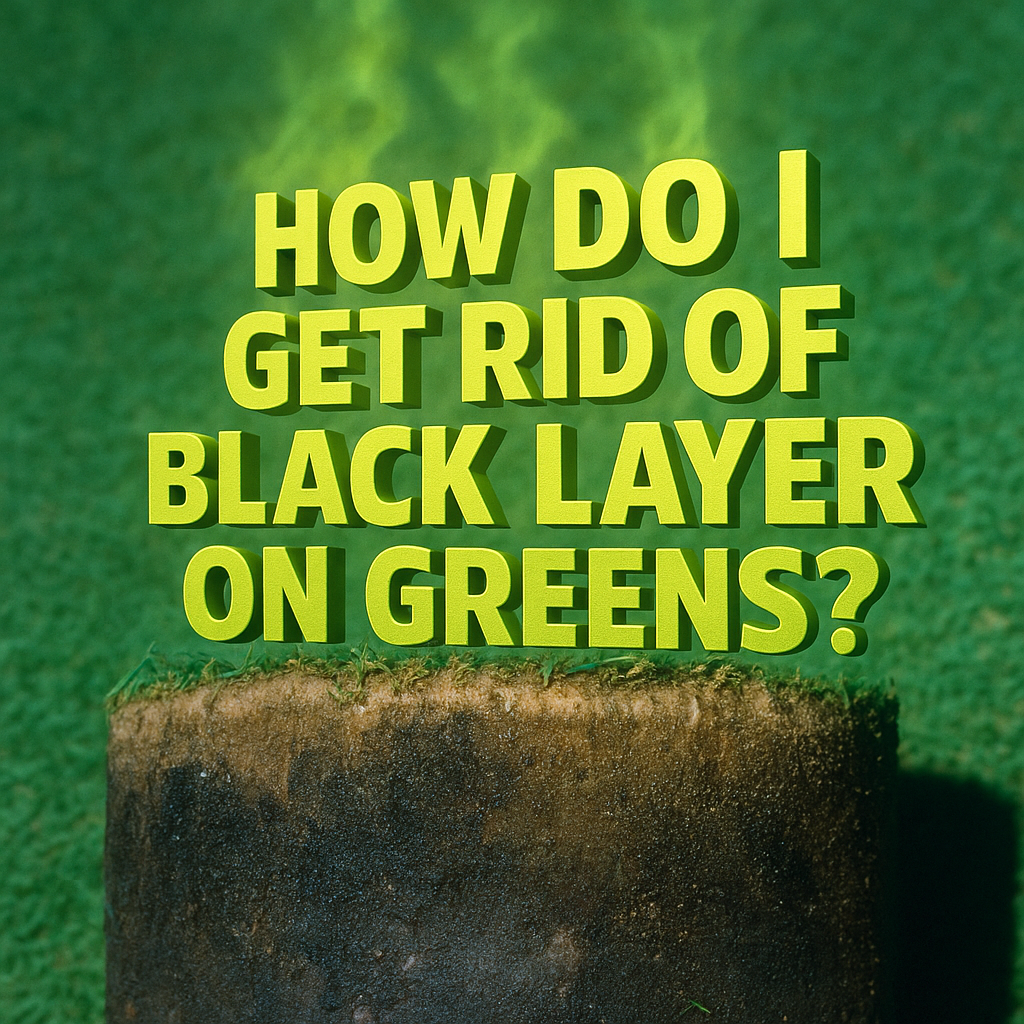What Is Black Layer and Why Is It a Problem?
If you’re managing putting greens and notice a foul odor, poor drainage, or dark streaks just beneath the surface, you’re likely dealing with black layer. This anaerobic soil condition is more than just unsightly—it’s a sign of serious turf decline and biological imbalance beneath your turf canopy.
Black layer is formed in the anaerobic (oxygen-depleted) pockets of your soil profile, often due to overwatering, compaction, thatch buildup, or poor drainage. When oxygen is absent, sulfate-reducing bacteria (SRBs) become dominant, converting sulfate (SO₄²⁻) into hydrogen sulfide gas (H₂S). This toxic gas smells like rotten eggs and is lethal to plant roots.
The result? Turf stress, root dieback, increased disease pressure, and a loss of soil structure. If left untreated, black layer can lead to significant turf loss, especially on high-stakes surfaces like golf greens.
The Biological Cause: Sulfate Reduction and H₂S Toxicity
Black layer is a textbook example of the collapse of the nitrogen cycle and the dominance of anaerobic bacteria. In healthy soils, aerobic microorganisms break down organic matter and support plant nutrition by cycling nitrogen and other elements efficiently.
But in saturated, oxygen-starved conditions, these beneficial aerobic microbes die off. Anaerobic bacteria take over and begin a process called sulfate reduction, which generates black iron sulfide (FeS) and hydrogen sulfide (H₂S) gas. The black color seen in the soil profile is primarily due to iron sulfide precipitates, while the damage to roots is largely due to H₂S toxicity.
The Solution: Restoring Aerobic Balance with Penterra and Agriox
To fix black layer, you need to do more than just poke holes in the soil. You need to break the anaerobic cycle, flush out the toxic gases, and reintroduce oxygen in a form that supports microbial recovery. Two products—Penterra and Agriox—work together to do exactly that.
Step 1: Apply Penterra to Open Up Soil Pores
Penterra is an advanced soil penetrant that enhances vertical water movement and improves oxygen diffusion deep into the root zone. Unlike conventional wetting agents that just reduce surface tension, Penterra actually increases the infiltration rate and pore connectivity, allowing gases like H₂S to escape and oxygen to move in.
Application Rate:
Apply Penterra at 64 oz per acre (or 1.5 oz per 1,000 sq ft) diluted in sufficient water to evenly cover the surface. It’s ideal to water in with 0.1–0.2 inches of irrigation immediately after application.
Benefits of Penterra:
-
Improves infiltration and drainage
-
Promotes oxygen movement into anaerobic pockets
-
Aids in flushing out hydrogen sulfide gas
-
Helps relieve compaction and improve root zone structure
Penterra is especially useful for high-traffic turf like golf greens, where black layer typically forms at 1–3 inches depth due to compaction and thatch.
Step 2: Apply Agriox to Deliver Controlled Oxygen Release
Agriox is a stabilized oxygen source designed to release oxygen into the soil over time. It acts like a “breath of fresh air” for anaerobic soils, fueling the aerobic microbes that help restore natural nutrient cycling and suppress the sulfate-reducing bacteria.
Application Rate:
Apply Agriox at 20 lbs per acre (0.5 lbs per 1,000 sq ft), ideally immediately after applying Penterra. Agriox can be lightly watered in or allowed to dissolve with rainfall or dew. It is non-burning and safe for all turf types.
Benefits of Agriox:
-
Reintroduces oxygen into the root zone gradually
-
Re-activates aerobic microorganisms
-
Suppresses hydrogen sulfide production
-
Rebalances the nitrogen and sulfur cycles
-
Enhances soil structure and root development
Agriox supports long-term recovery by restoring biological activity where it’s most needed.
Why These Two Together Work So Well
Used alone, most products only address one symptom of black layer—either water movement or oxygen deficiency. But Penterra + Agriox work synergistically to address the root cause:
-
Penterra opens the soil so oxygen and water can move freely.
-
Agriox supplies the oxygen needed to reestablish healthy, aerobic microbial populations.
-
Together, they flush toxic gases, re-oxygenate the soil, and re-engage the natural biological balance.
Over time, this dual approach disrupts the sulfate-reducing environment and restores natural nitrogen cycling, leading to visibly healthier turf, stronger roots, and improved resilience.
Maintenance Recommendations After Treatment
To prevent black layer from returning:
-
Aerify regularly to reduce compaction
-
Manage thatch with topdressing and biological products
-
Use soil oxygenation treatments quarterly or as needed
-
Avoid over-irrigation—monitor moisture levels carefully
-
Encourage microbial diversity with humic acid and carbon-based products
If needed, Penterra and Agriox can be used monthly during peak stress seasons, especially in regions with poor drainage, high sulfate irrigation water, or heavy play.
Real-World Results
Turf managers using this protocol report:
-
Faster recovery of weak areas
-
Elimination of black streaks in soil cores
-
Noticeable reduction in sulfur odor
-
Increased rooting depth and density
-
Better putting quality and ball roll on greens
It’s a cost-effective and agronomically sound solution that doesn’t rely on aggressive chemistry or surface disruption.
Final Thoughts
Black layer is not just a surface issue—it’s a symptom of biological imbalance and anaerobic collapse beneath the turf. By restoring oxygen flow and microbial balance, you empower your greens to recover and resist future stress.
With Penterra at 64 oz per acre and Agriox at 20 lbs per acre, you can stop the sulfur cycle in its tracks, reduce H₂S toxicity, and bring your soil biology back to life.
If you’re battling black layer on your greens, this is the proven system that works—flush it, oxygenate it, and bring it back to balance.

